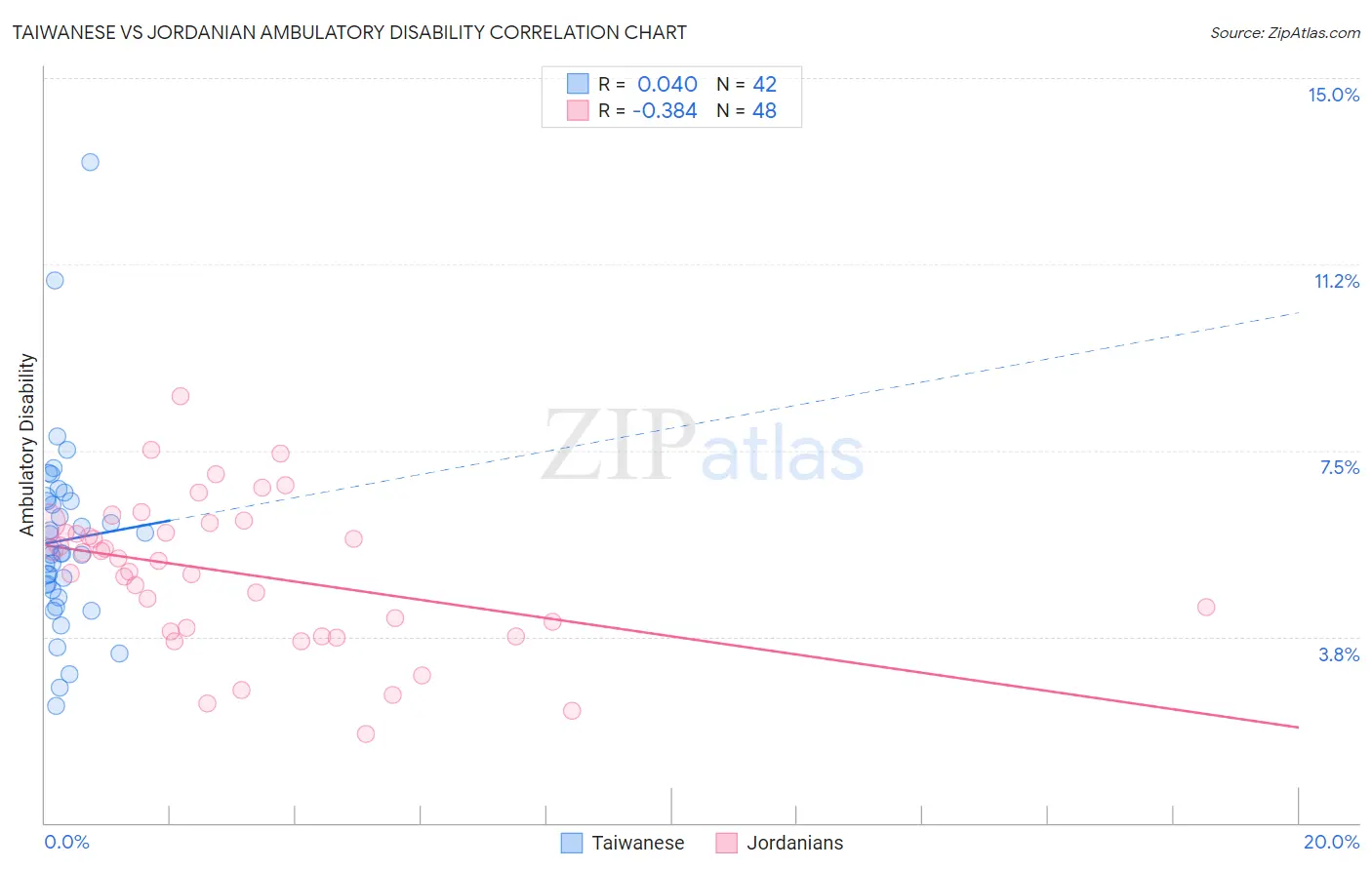Taiwanese vs Jordanian Ambulatory Disability
COMPARE
Taiwanese
Jordanian
Ambulatory Disability
Ambulatory Disability Comparison
Taiwanese
Jordanians
5.6%
AMBULATORY DISABILITY
99.8/ 100
METRIC RATING
51st/ 347
METRIC RANK
5.6%
AMBULATORY DISABILITY
99.8/ 100
METRIC RATING
52nd/ 347
METRIC RANK
Taiwanese vs Jordanian Ambulatory Disability Correlation Chart
The statistical analysis conducted on geographies consisting of 31,722,995 people shows no correlation between the proportion of Taiwanese and percentage of population with ambulatory disability in the United States with a correlation coefficient (R) of 0.040 and weighted average of 5.6%. Similarly, the statistical analysis conducted on geographies consisting of 166,412,494 people shows a mild negative correlation between the proportion of Jordanians and percentage of population with ambulatory disability in the United States with a correlation coefficient (R) of -0.384 and weighted average of 5.6%, a difference of 0.090%.

Ambulatory Disability Correlation Summary
| Measurement | Taiwanese | Jordanian |
| Minimum | 2.4% | 1.8% |
| Maximum | 13.3% | 8.6% |
| Range | 11.0% | 6.8% |
| Mean | 5.7% | 5.0% |
| Median | 5.4% | 5.3% |
| Interquartile 25% (IQ1) | 4.7% | 3.9% |
| Interquartile 75% (IQ3) | 6.5% | 5.9% |
| Interquartile Range (IQR) | 1.8% | 2.1% |
| Standard Deviation (Sample) | 1.9% | 1.5% |
| Standard Deviation (Population) | 1.9% | 1.5% |
Demographics Similar to Taiwanese and Jordanians by Ambulatory Disability
In terms of ambulatory disability, the demographic groups most similar to Taiwanese are Luxembourger (5.6%, a difference of 0.10%), Immigrants from Egypt (5.6%, a difference of 0.10%), Immigrants from Eastern Africa (5.6%, a difference of 0.15%), Immigrants from Bulgaria (5.6%, a difference of 0.21%), and Inupiat (5.6%, a difference of 0.30%). Similarly, the demographic groups most similar to Jordanians are Immigrants from Egypt (5.6%, a difference of 0.010%), Immigrants from Eastern Africa (5.6%, a difference of 0.060%), Immigrants from Bulgaria (5.6%, a difference of 0.12%), Luxembourger (5.6%, a difference of 0.19%), and Inupiat (5.6%, a difference of 0.21%).
| Demographics | Rating | Rank | Ambulatory Disability |
| Mongolians | 99.9 /100 | #41 | Exceptional 5.5% |
| Argentineans | 99.9 /100 | #42 | Exceptional 5.5% |
| Paraguayans | 99.9 /100 | #43 | Exceptional 5.5% |
| Immigrants | Indonesia | 99.9 /100 | #44 | Exceptional 5.5% |
| Immigrants | Sweden | 99.9 /100 | #45 | Exceptional 5.6% |
| Egyptians | 99.9 /100 | #46 | Exceptional 5.6% |
| Immigrants | Japan | 99.9 /100 | #47 | Exceptional 5.6% |
| Immigrants | Argentina | 99.9 /100 | #48 | Exceptional 5.6% |
| Bulgarians | 99.9 /100 | #49 | Exceptional 5.6% |
| Luxembourgers | 99.9 /100 | #50 | Exceptional 5.6% |
| Taiwanese | 99.8 /100 | #51 | Exceptional 5.6% |
| Jordanians | 99.8 /100 | #52 | Exceptional 5.6% |
| Immigrants | Egypt | 99.8 /100 | #53 | Exceptional 5.6% |
| Immigrants | Eastern Africa | 99.8 /100 | #54 | Exceptional 5.6% |
| Immigrants | Bulgaria | 99.8 /100 | #55 | Exceptional 5.6% |
| Inupiat | 99.8 /100 | #56 | Exceptional 5.6% |
| Immigrants | Brazil | 99.8 /100 | #57 | Exceptional 5.6% |
| Immigrants | Zimbabwe | 99.8 /100 | #58 | Exceptional 5.6% |
| Immigrants | Afghanistan | 99.8 /100 | #59 | Exceptional 5.6% |
| Immigrants | Lithuania | 99.8 /100 | #60 | Exceptional 5.6% |
| Immigrants | Belgium | 99.7 /100 | #61 | Exceptional 5.6% |